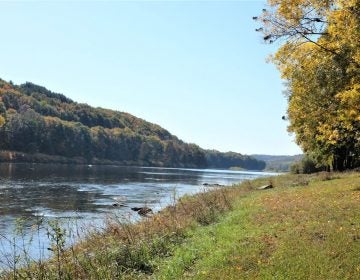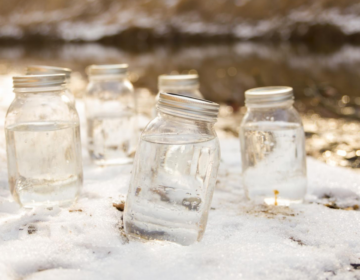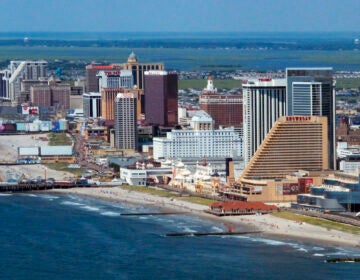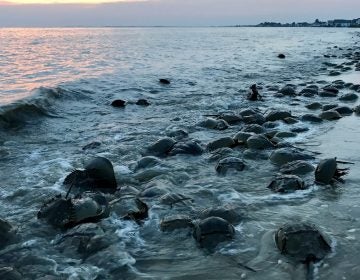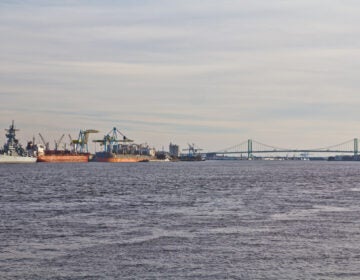It’s the last of the Delaware River’s shad fisheries, and the fish are scarce
For the American shad, challenges extend far beyond the Delaware River.

For Steve Meserve of the Lewis Fishery, the preferred method of setting the seine is by rowing, because he has found that a motor affects the shad hauls. (Andrew S. Lewis/NJ Spotlight)
This story originally appeared on NJ Spotlight.
___
Steve Meserve wasn’t feeling optimistic. A storm front had moved in overnight and a cold, west-northwest wind was running down the river. The 54-degree water temperature, he said, “makes the shad want to sit down in an eddy somewhere and wait for warmer weather.”
But here in Lambertville, on a wide and deep reach of the Delaware River, this spring’s shad run has been good, even promising. As they have done most every night from late March through May since 1888, fishermen from Lewis Fishery slipped on hip waders and prepared a battered flat-bottom and seine for the evening’s haul.
For centuries, the shad spawn has been celebrated by Delaware watershed fishermen and -women, from the South Jersey Bayshore all the way up to the confluence of the river’s west and east branches in Hancock, New York, some 200 miles away. The contemporary run, however, is a fraction of what it was in the early nineteenth century, when Philadelphia fishmongers would boast that one could just about walk across the river on a carpet made of the deep green-purple backs of the American shad.
Officially, the most recent stock assessment from the Atlantic States Marine Fisheries Commission concludes that, East Coast-wide, the American shad population remains at historic lows. For years, no one has been exactly sure why.
The shad boom, a long time ago
The Lewis Fishery is the last of its kind on the Delaware River. In 1888, Meserve’s great-grandfather, Bill Lewis, took over an existing commercial shad operation on an 8-acre section of a narrow island that sits a few yards off the shoreline of downtown Lambertville, just north of the New Hope-Lambertville Bridge. Back then, the river was producing between 3 million and 4 million harvested shad each year — the largest amount by an order of magnitude than any other shad fishery on the Atlantic coast.
Lewis’s first years in business turned out to be the last of the boom — “a final cashing in on a once renewable resource,” as the historian Charles Hardy put it. Back then, the causes of the collapse of the watershed’s shad population were clear. Overfishing and the damming or obstructing of key spawning tributaries triggered the first decline in the mid-1800s. A century later, it was point source pollution from rapidly growing Philadelphia and Camden — mainly untreated sewage and industrial effluent — that led to the second collapse.
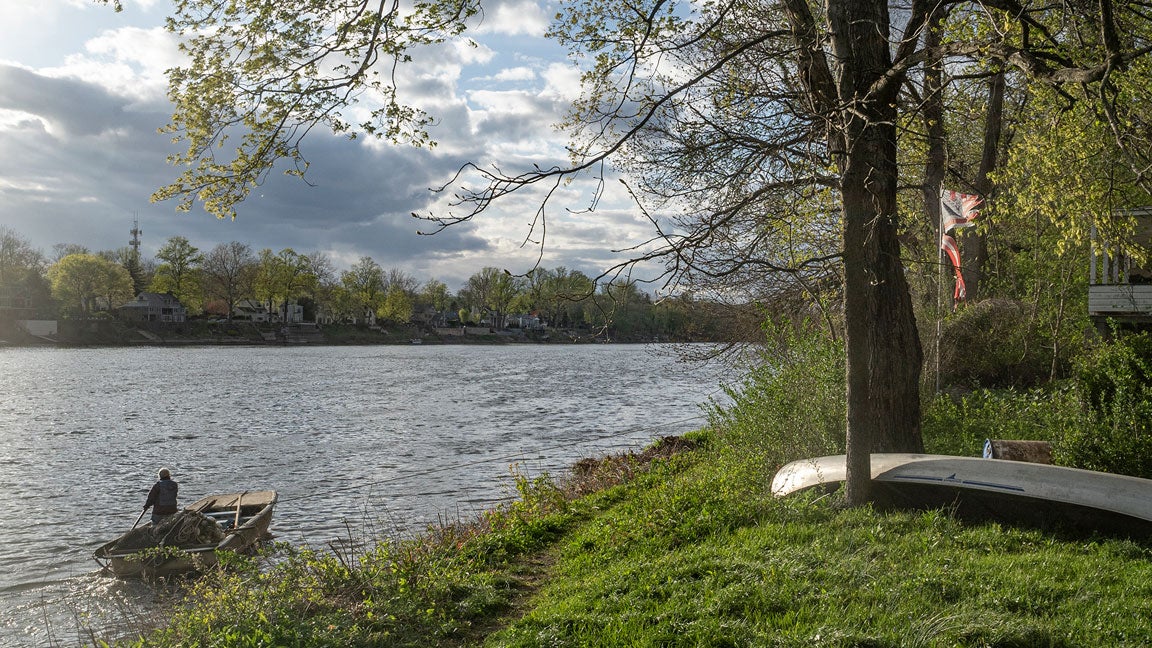
Despite the lean decades, and as the other shad fisheries on the river systematically closed down, Bill Lewis kept fishing.
“My great-grandfather was stubborn,” Meserve, who is 59, said. “He knew if he left, there would be no voice for the fish.”
Eventually, Lewis’s son, Fred, took over the business, then Fred’s kids. Meserve and his wife, Sue, and sister, Pam, run the fishery today, along with a dedicated group of other family, friends and volunteers.
There is little culinary interest in shad these days — “You can’t give them away to restaurants,” said Meserve — so the Lewis Fishery’s primary purpose is as that lonely voice for the Delaware River shad. In stacks of notebooks, Meserve holds an unbroken, 130-year-old set of near-daily haul data that is coveted by the Delaware River Basin Fish and Wildlife Cooperative, which oversees the management of the American shad in the watershed, and other fisheries researchers.
“When Steve walks into one of their meetings, everything stops,” Sue said. “His on-the-ground knowledge of these fish is a rarity.”
A push to thrive, not just survive
By the 1960s, a roughly 30-mile stretch of the Delaware River around Philadelphia was so polluted with residential and industrial wastewater that bacteria had consumed most of the oxygen in the water. For shad, this dead zone presented an impenetrable wall standing between them and their spawning grounds. In those years, few shad turned up in the Lewis Fishery’s nets.
“My great-grandfather was a part of the collective voice calling for the passage of legislation that would address water pollution,” Meserve said. “His feeling that there needed to be someone watching over the river got passed on to us.”
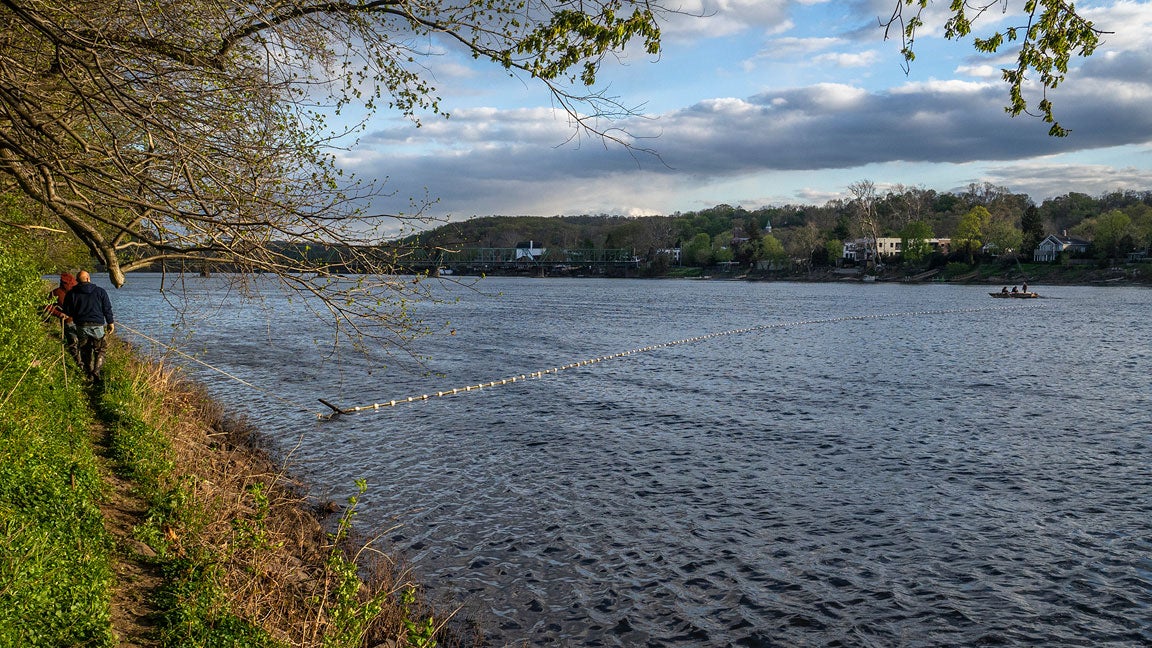
The legislation Bill Lewis helped push for would come in the form of the Federal Water Pollution Control Act, in 1948, 1968’s Wild and Scenic Rivers Act and 1969’s National Environmental Policy Act. The Clean Water Act, passed in 1972, codified wastewater standards and initiated the steady improvement of American waterways, including the re-oxygenation of the Delaware River’s dead zone.
“We’ve come a really long way,” said Kate Schmidt, a spokesperson for the Delaware River Basin Commission, the interstate body that oversees water quality throughout the watershed. “By the early eighties, we were getting dissolved oxygen levels that were above standard in the part of the river where there had been none.”
But the Delaware Riverkeeper’s Maya van Rossum contends that pollution levels in the watershed remain too high, and that agencies like the Delaware River Basin Commission need to do more to improve water quality. With one of the nation’s largest concentrations of chemical and petrochemical plants, the Delaware River is constantly being subjected to toxic effluent — the impacts of some well understood, but those of other, newer chemicals far less so.
“Shad may not be about to disappear, but these are certainly not healthy populations,” said van Rossum. “The dissolved oxygen standard that was set over 50 years ago is still in place today — this is something the commission can and should be fixing, so that shad are not just surviving in our river, but thriving.”
A new, more complex challenge from offshore fisheries
While the causes of the Delaware River and Bay’s shad collapses were once confined to sources within the watershed — overfishing, damming and pollution — today they also extend far off the Atlantic coast, beyond the protection of the states and agencies like the Delaware River Basin Commission.
American shad are an anadromous species, meaning they begin their lives in rivers, then migrate to the ocean where they live for the next four to six years, before returning to their natal rivers to spawn. They are also a forage fish — throughout their life cycle, they remain food for a variety of wildlife species, from tuna to osprey, thus are a vital conduit of energy across the food chain.
Forage fish are also dense schoolers, making them susceptible to being swept up in large numbers by the seines of Atlantic mackerel and sea herring commercial fisheries operating off the East Coast. But, as a forage fish, they are not afforded the same protections as market species under the Magnuson-Stevens Act, the primary fishing law of the United States.
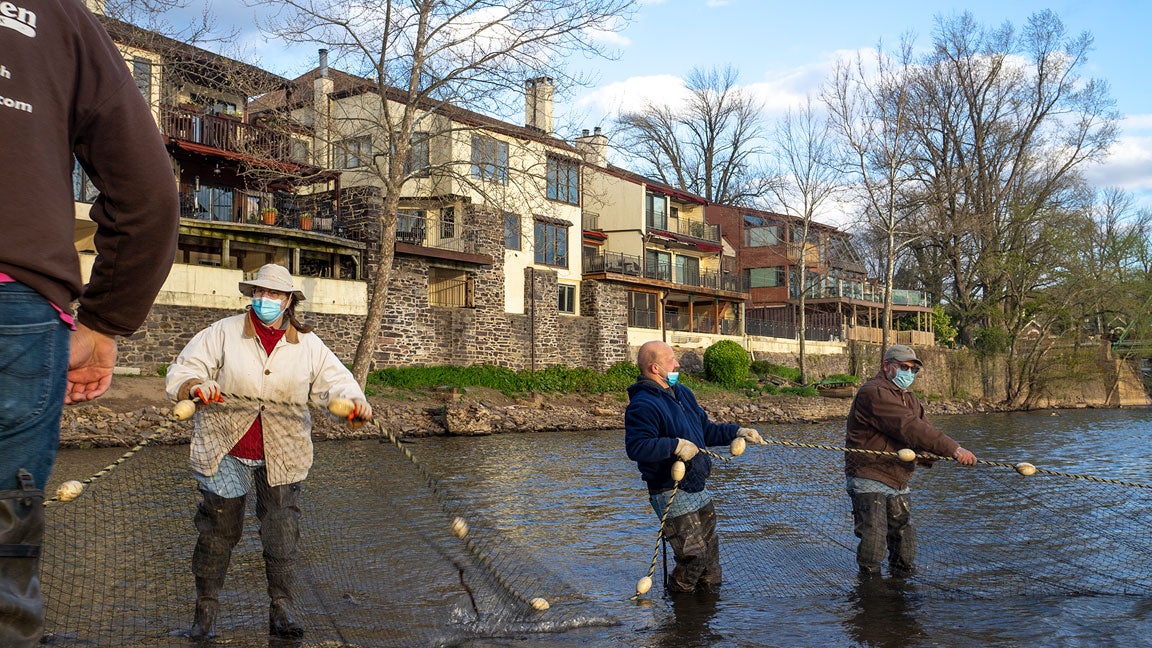
“For decades, state and local governments, hundreds of restoration practitioners, and thousands of volunteers have worked to improve water quality, increase connectivity through culvert and dam removal or renovation, and impose recreational and commercial catch limits in state waters,” said Zack Greenberg, a Pew Charitable Trusts officer who leads marine conservation efforts and outreach along the East Coast. “All of these efforts have been going on, but populations remain at or near historic lows, so that gap in federal management is a big concern.”
In 2019, U.S. Rep. Debbie Dingell (D-MI) introduced the Forage Fish Conservation Act, which would provide protections for species like shad, as well as provide funding for research that would inform better management of forage fish. Currently, shad bycatch limits are imposed on commercial mackerel and sea herring fisheries, but those limits are loosely defined and not based on the fish’s biology or ecosystem-wide science.
“The bycatch cap in the Atlantic mackerel fishery is 129 metric tons of river herring and shad, which is about three-quarters to a million individual fish,” Greenberg said. “Some of these East Coast runs number in the hundreds to thousands of individual fish, so right there you have the potential to just wipe out an entire river’s run for that year.”
Dingell’s bill never received a vote, and while it was co-sponsored by Democratic and Republican congressmen and -women from Pennsylvania and New York, along with others from ten additional states, no representatives from New Jersey supported the legislation.
In December, Richard Blumenthal (D-CT) introduced a companion bill in the Senate. That, too, didn’t get any traction. But advocates like Pew’s Greenberg remain hopeful that Blumenthal, Dingell and other legislators will push ahead and introduce new bills in this session.
“We’re pretty confident that we’ll see a bipartisan effort to get this bill passed,” Greenberg said. “I would expect folks to be actively talking to offices from most of the East Coast states.”
‘The job’s not done’
Around sunset, Meserve and his crew gathered on the old boat ramp on the south end of Lewis Island and began hauling in 200 yards of seine. As net gathered around their feet, a group of spectators and a few customers assembled on a nearby bank. For a while, it appeared that Meserve’s lack of optimism might have been on the spot, but then the water started swirling and flashing.
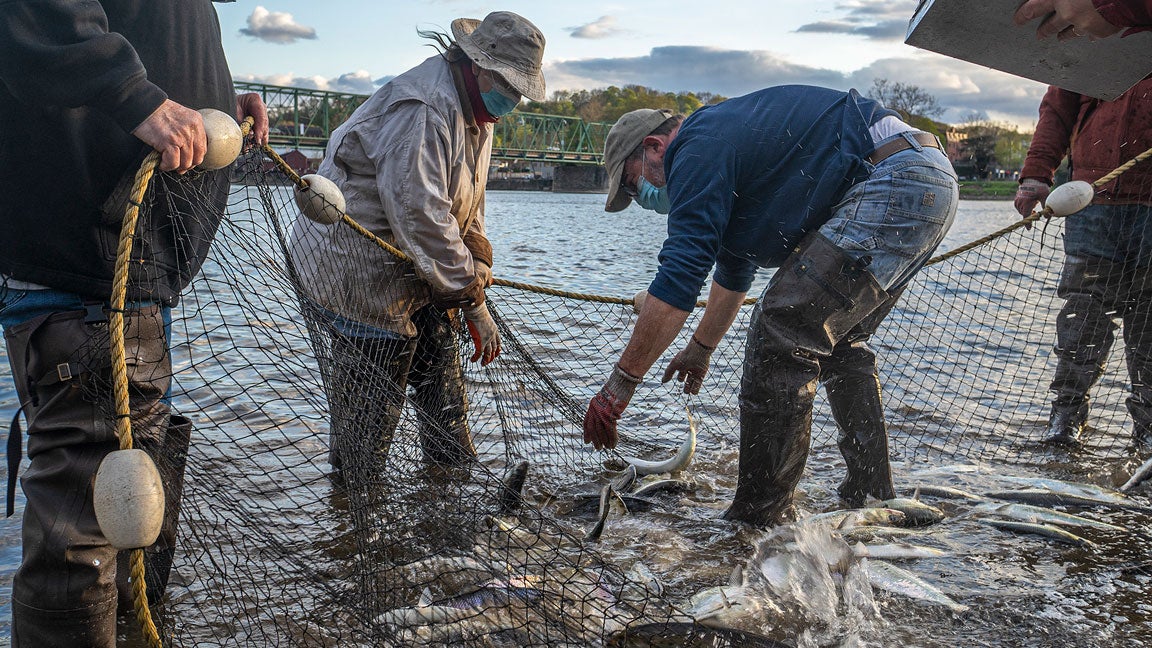
Meserve was soon surrounded by a rollicking ensemble of 84 shad, one gizzard shad, one smallmouth bass, one catfish, and one lamprey eel. Meserve called out each shad’s sex — “buck” or “roe” — then either threw them back (65) or kept them to be recorded and, hopefully, sold (19). It was the best haul of the season, so far.
“You just never know what the river’s going to turn up,” Meserve said, before disappearing into a nearby shed, built by his grandfather, to warm up with the others next to a woodstove.
While Sue Meserve fielded a handful of orders for fish, Pam Baker, Meserve’s sister, and longtime volunteer Charlie Groth recorded the weight and length of each fish, then gathered scales to be sent to the Delaware River Basin Fish and Wildlife Cooperative for research.\
That the Lewis Fishery is the last commercial shad operation on the Delaware River is “a sad story of loss for our river and our communities, but it doesn’t have to be,” van Rossum said. “It could be a great story of victory if our government officials at every level rise up and take on the challenge of doing what is necessary to advance restoration. We’ve made progress, but the job’s not done.”
In the meantime, Meserve will be on Lewis Island every night in spring, doing what his family has always done, even if today it’s mainly for research.
“We do this to help maintain a knowledge of where the fish are,” he said. “Because we want to figure out what’s going on.”
WHYY is your source for fact-based, in-depth journalism and information. As a nonprofit organization, we rely on financial support from readers like you. Please give today.


